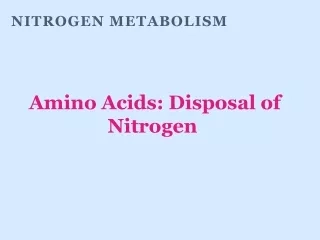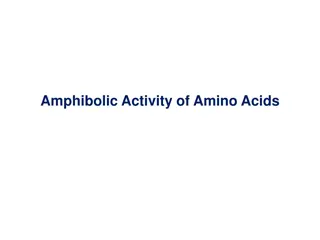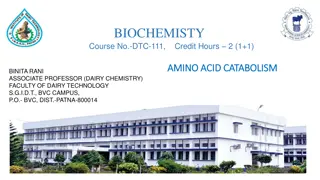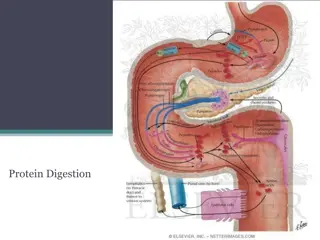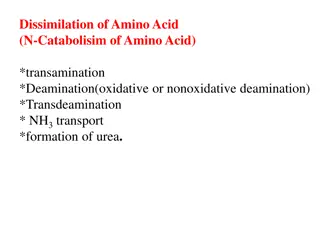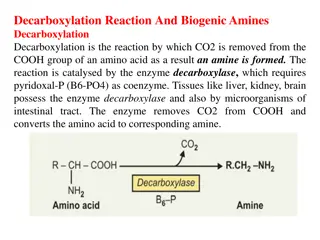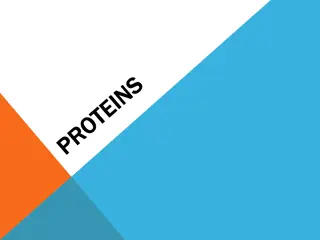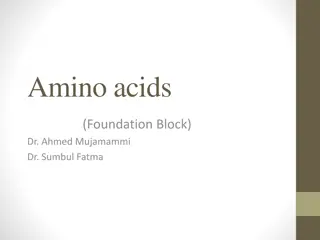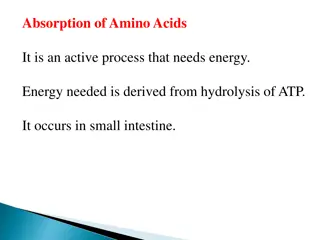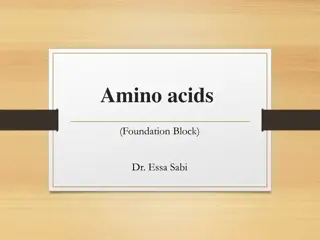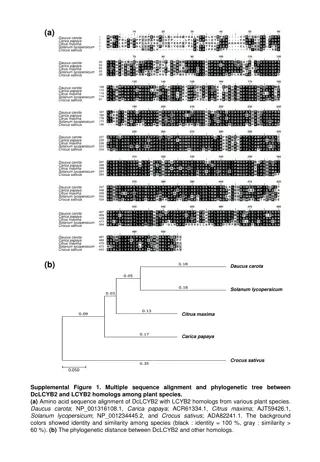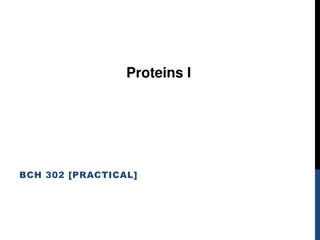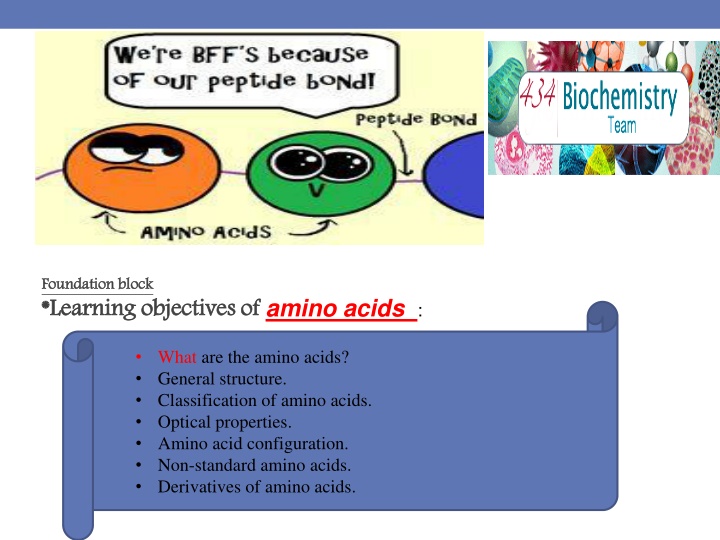
Amino Acids: Structure, Classification, and Properties
Discover the fundamentals of amino acids, including their general structure, classification, optical properties, and isoelectric point. Learn about the role of amino acids as building blocks of proteins, their diverse configurations, and the significance of non-polar amino acids in biological systems.
Uploaded on | 0 Views
Download Presentation

Please find below an Image/Link to download the presentation.
The content on the website is provided AS IS for your information and personal use only. It may not be sold, licensed, or shared on other websites without obtaining consent from the author. If you encounter any issues during the download, it is possible that the publisher has removed the file from their server.
You are allowed to download the files provided on this website for personal or commercial use, subject to the condition that they are used lawfully. All files are the property of their respective owners.
The content on the website is provided AS IS for your information and personal use only. It may not be sold, licensed, or shared on other websites without obtaining consent from the author.
E N D
Presentation Transcript
Foundation block *Learning objectives of Foundation block *Learning objectives of amino acids : What are the amino acids? General structure. Classification of amino acids. Optical properties. Amino acid configuration. Non-standard amino acids. Derivatives of amino acids.
What amino acids are? *building blocks of proteins . *Organic acids that contains a side chain(R) Group that makes each amino acid different ,Hydrogen atom and two functional Groups: (COOH) Carboxylic group (NH2) Amino group *Half of the 20 amino acids can be produced by humans , the other half must be supplied in the food . *Amino acids plays an intermediates in metabolism . Common to all -amino acid of proteins intermediates role
Isoelectric point In acidic solution-cationic. In alkaline solution- anionic.
Isoelectric point is the PH at which an amino acid is electrically neutral . Which means that the sum of the + charge equals the sum of the charge . (the net charge = ZERO) The amino acid at isoelectric point is called zwitterion .
pK Value - Ability of an acid to donate a proton (how fast it dissociates) - Known as pKa or Acid Dissociation Constant. - Carboxylic group = 2.2 (gives proton in LOW pH) - Amino group = 9.4 (gives proton in HIGH pH)
Non Polar Amino Acids. This kind of amino acids formed when R group isn t polar(has no net charge). So,,what are non polar amino acids?? The amino acids that don t (give=bind off=participate) protons in hydrogen or ionic bond. If the protein was located in aqueous solution(hydrophilic environment), the non polar side chains will cluster together in the interior of the protein On the other hand if it was located in hydrophobic environment, the R groups will be on outside surface interacting with lipid environment.
Examples of non polar amino acids As you see, PROLINE(secondary amino group) has different structure from other non polar amino acids. its -amino group form a ring structure (an IMINO GROUP).
UNCHARGED AMINO ACIDS These amino acids have zero net charge at neutral pH. Cysteine Asparagine Therionine Glutamine Tyrosine serine The side chains of cysteine and tyrosine can lose a proton at an alkaline ( basic ) pH. Serine, Therionine and Tyrosine each contain a polar hydroxyl group that can participate in hydrogen bond formation. The side chains of asparagine and glutamine each contain a carboxyl group and an amide group, both of which can also participate in hydrogen bonds.
Polar amino acids Amino acids with basic side chains: Amino acids with acidic side chains : Histidine Arginine Aspartic acid glutamic acid Lysine They are are proton donors. They are proton acceptors. At neutral pH, these amino acids are fully ionized (negatively charged). So, they are called aspartate and glutamate At neutral pH, lysine and arginine are fully ionized (positively charged).
Optical properties Asymmetrical symmetrical -C attached to 4 different groups -C is not attached to different groups Active Inactive The ability to rotate the plane of polarized light in a polarimeter. All amino acids are optically active except glycine. The inability to rotate the plane of polarized light in a polarimeter.
Amino acid configuration They are chemically the same. L- Amino Acid D- Amino Acid Rotate polarized light to the left. Rotate polarized light to the Right. Rotation : Natural amino acid * All mammalian Amino acids are in L- configuration 1.Antibiotics. 2. Plants Bacterial cell walls. Found in :
NON-STANDARD AMINO ACIDS Some uncommon amino acid residues that are components of certain proteins
Gamma amino butyric acid (GABA) Derivative of glutamic acid Dopamine from Tryosine Neurotransmitters Histamine from Histidine Mediator of allergic reaction Throxine from Tryosine Thyroid Hormone
Quiz yourself : quiz Helpful videos: Our biochemistry heroes: Our biochemistry heroes: Amino Acid Structure: Memorize the 20 amino acids: Isoelectric Point and Zwitterions:

